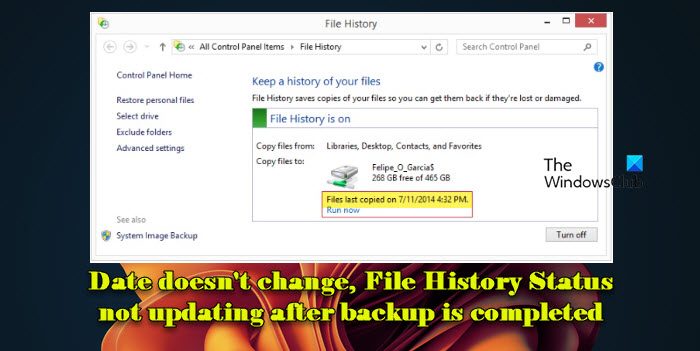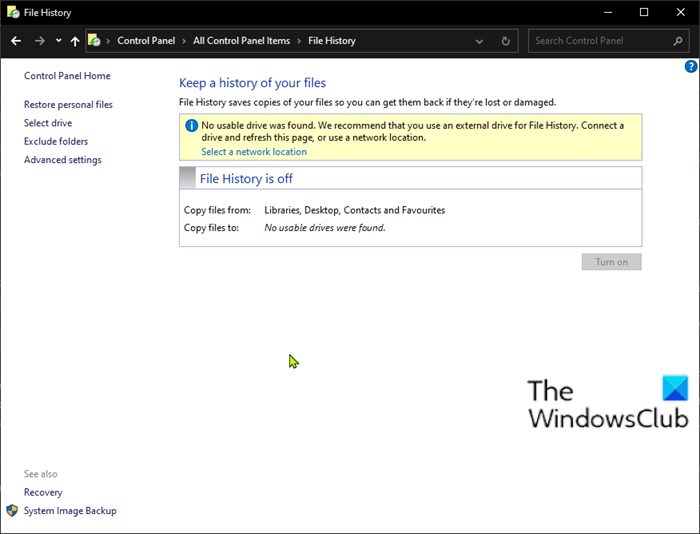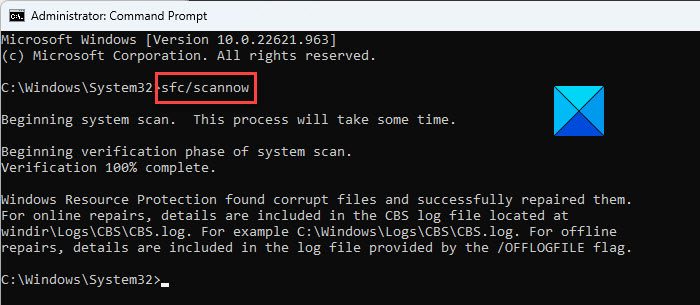If you notice that the date of the latest File History backup on your Windows 11/10 hasn’t changed after the last automatic backup operation, even though you have the default set to run daily and keep forever, then this post is intended to help you. In this post, we will offer the appropriate solutions you can try to help you resolve this anomaly.

File History is Windows’ main backup tool, originally introduced in Windows 8. Despite the name, File History isn’t just a way to restore previous versions of files–it’s a fully-featured backup tool. After you set up File History, you can just connect an external drive to your computer and Windows will automatically back up your files to it.
File History feature replaces Backup and Restore in previous versions of Windows and currently exists in Windows 11/10 – an application that continuously backs up the files in your Libraries, on your Desktop, in your Favorites folders, and in your Contacts folders. It defaults to doing this on an hourly basis as long as the File History device, typically an external hard drive, is attached. It will not erase files and folders previously saved to the drive, as it stores everything in a top-level folder named FileHistory.

File History will NOT backup anything saved to your OneDrive storage, even if they are stored in the libraries File History backs up. You can back up additional files by adding them to the Documents library.
Date doesn’t change after File History backup is completed
If the date of the latest File History backup hasn’t changed after the last automatic backup operation on your Windows 11/10 PC, you can try our recommended solutions in the order presented below to resolve the issue.
- Run SFC and DISM scan
- Reset File History to default settings
Let’s take a look at the description of the process involved concerning each of the listed solutions.
1] Run SFC and DISM scan

If you have system file errors, you may encounter the Date doesn’t change after the File History backup is completed issue.
The SFC and DISM are utility software in Windows that allows users to scan for corruptions in Windows system files and restore corrupted files.
To run the SFC scan, execute sfc /scannow in an elevated Command Prompt.
Alternatively, you can run both the scans using the procedure below.
- Press Windows key + R to invoke the Run dialog.
- In the Run dialog box, type notepad and hit Enter to open Notepad.
- Copy and paste the syntax below into the text editor.
@echo off date /t & time /t echo Dism /Online /Cleanup-Image /StartComponentCleanup Dism /Online /Cleanup-Image /StartComponentCleanup echo ... date /t & time /t echo Dism /Online /Cleanup-Image /RestoreHealth Dism /Online /Cleanup-Image /RestoreHealth echo ... date /t & time /t echo SFC /scannow SFC /scannow date /t & time /t pause
- Save the file with a name and append the .bat file extension – eg; SFC_DISM_scan.bat.
- Repeatedly run the batch file with admin privilege (right-click the saved file and select Run as Administrator from the context menu) until it reports no errors.
- Restart your PC.
On boot, check if File History reflects the most recent backups. Otherwise, proceed with the next solution.
2] Reset File History to default settings
Resetting this feature to default will not remove your files stored on a drive configured for File History. They will remain stored in the FileHistory folder in the root folder of the drive.
To reset File History to default settings in Windows 11/10, do the following:
- Press Windows key + R to invoke the Run dialog.
- In the Run dialog box, type control and hit Enter to open the Control Panel.
- In Control Panel (View by: Large icons), locate and click File History.
- If you have enabled File History, click Turn off.
You can now exit the File History applet.
- Next, open the Run dialog again, copy and paste the directory path below and hit Enter.
%UserProfile%\AppData\Local\Microsoft\Windows\FileHistory
- Now, press CTRL + A to highlight all folders/files present in the directory.
- Tap Delete key on your keyboard.
The File History configuration will be removed. You can now proceed to recreate the File History backup per your requirement.
Going forward, you shouldn’t encounter this issue on Windows 11/10.
That’s it!
Note: File History ignores files that are in use when applications are open, such as Outlook.pst files if Outlook is open. To back up all files, shut down all programs, and use the Run now option in File History to manually update the file history OR do a traditional drag-and-drop backup.
It’s recommended that you verify your backups.
Read: How to reset Windows Backup and Restore to Default in Windows.
Why is File History not backing up?
If File History is not backing up data on your Windows 11/10 PC, the designated backup drive might be disconnected, services related to File History might not be running, File History settings might have gone corrupted, or File History may not be having the necessary permissions to access or write to the files or backup drive. Go to Control Panel > System and Security > File History and ensure the feature is enabled. Also, ensure that the correct backup drive is selected and that it is accessible. Next, open Windows Services Manager, right-click ‘File History Service’, and click Restart.
Does File History backup everything?
File History does not back up everything on a Windows 11/10 PC. By default, it backs up libraries like Documents, Music, Pictures, Videos, and Desktop, and some other folders in a user account, and also allows you to specify which libraries, folders, and drives you want to include in your backups. File History does not back up system files, applications, or the entire operating system. For full system backup, you may use other tools like system image backup or third-party software.
Read Next: How to delete File History backups manually in Windows.
Leave a Reply